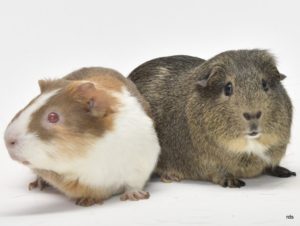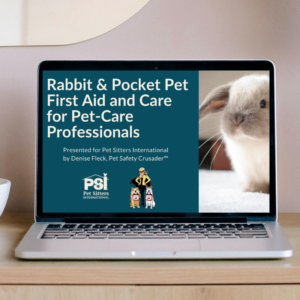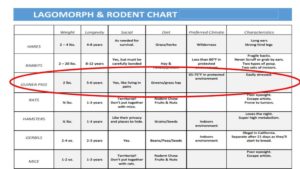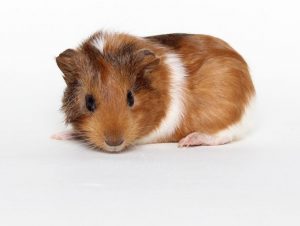
Guinea Pigs are classified as rodents, and about 40% of all mammals are Rodents. More than 2,000 species inhabit the planet and they are characterized by a single pair of continuously growing incisors in both the upper and lower jaws. Rodents are found in large numbers on every continent, except Antarctica, and many species have been domesticated and welcomed as part of human families. Just like other family members, sometimes guinea pigs get ill or injured.
Would you know what to do? If you are a guinea pig parent or caregiver, don’t delay in learning the basics.  Sign up for this pet first aid course that can teach you how to help some of our smallest family members even before veterinary care is available: http://www.petsafetycrusader.com/shop/classes/first-aid-basics-for-rabbits-pocket-pets-webinar/
Sign up for this pet first aid course that can teach you how to help some of our smallest family members even before veterinary care is available: http://www.petsafetycrusader.com/shop/classes/first-aid-basics-for-rabbits-pocket-pets-webinar/
About Guinea Pigs
- Guinea pigs or “Cavies*” are easily stressed. They should be handled gently by picking up with one hand under chest and another supporting their hind-quarters while held against your chest.
- Life span: 5-6 years
- Size: About 2 lbs.
- Diet: Greens (kale, cabbage, grass hay)
- Climate: Room Temperature
- Playmates: Guinea Pigs do well living in pairs.
* The taxonomic name for guinea pigs is Cavia porcellus, indicating the genus Cavia and species porcellus. Cavy and its plural form, cavies, derives from the genus Cavia and therefore “Cavy.”

Getting to Know Your Cavy from Head-to-Tail
Not all guinea pigs enjoy being held, so your furry little pal may feel more comfortable if you sit on the floor with her in front of you. It is key to go at a pace that is comfortable for her. Do this only when you are relaxed yourself, as animals always pick up on our stresses and besides finding health issues, this should be a good bonding time for you both.
Starting at the ears, look inside to make sure nothing is red or infected and there is no presence of mites. Many guinea pigs enjoy a gentle scratch between the ears.
Look at your piggie’s eyes to make sure they aren’t tearing excessively and that they look bright and clear.
That twitching nose shouldn’t be runny or have any type of discharge. Your cavy may wipe her face, so dirty paws can be the sign of a runny nose.
It may take quite some time for your guinea pig to feel comfortable with you looking inside her mouth, so to inspect teeth, feel along each side of the face and under the jaw. Sides should feel equal – no lumps or swelling. If you apply slightly firmer pressure and your guinea pig flinches, there may be a painful area inside the mouth (although some guinea pigs may flinch simply due to the dislike of being handled). Gums should be pink (unless they naturally have a darker pigment). Guinea pigs have 20 continually growing sharp teeth: 4 incisors (2 upper and 2 lower), no canines, 4 premolars (2 upper and 2 lower), and 12 molars (6 upper and 6 lower). Be sure you always provide something to chew on to prevent malocclusion – a condition wear the teeth grow too long and won’t properly close resulting in an inability to properly chew food. Twigs from fruit trees (apple for instance) are a great choice just make sure they haven’t been sprayed with chemicals and also… toilet paper/paper towel rolls.
As you start to gently feel across her shoulders and down her back, a gentle combing might be welcomed.
Next rub your fingertips ever so carefully down each leg and check the pads of her feet looking for cuts, scrapes, lumps & bumps. Check those nails when you reach the paw pads and look between toes. Rabbit nails should be trimmed monthly and like our dogs and cats, there is a quick or blood supply, so just little clips at a time to prevent bleeding. Ask your veterinarian to show you how. Short nails are less likely to get torn from catching in carpet or on their pen limiting her pain and your need to perform first aid.
Feel your piggie’s abdomen. Her tummy should never feel hard or even like a water balloon which could alert you to bloat (see below), an emergency situation. Make sure there is no unusual discharge from the nipples or genitalia. Urine scald can be painful. When guinea pigs urinate, sometimes the urine soaks the fur in the groin, and if she doesn’t clean it, the urine can burns the skin. Check with your vet if Virbac Allercalm® or a similar shampoo would be best for regular “butt baths” and what calming cream (Zinc oxide, white Vaseline) he or should suggests. Urine scald can be caused by various urinary tract and other ailments, as well as unkempt litter boxes. A veterinary visit is in order if this happens more than once.
After you feel your way down the hips, back legs and paws (like you did the front legs) don’t forget to check the tail as well for lumps, bumps, discharge, fleas, cuts, scrapes or anything that shouldn’t be there. Cavies have a grease gland that produces an oily secretion for scenting and marking. Place your cavy on a tabletop facing away from you, and at the end of her spine, where her tail should be, brush away the fur to uncover a dime-sized area with an accumulated build-up. Gently rub in coconut oil to clean and degrease and prevent infection. Shampoo if needed.
By knowing what is normal for your precious guinea pig, you can more quickly determine when something is not right and get her professional medical attention.

Your Guinea Pigs’ Vital Signs
As you’re doing your Head-to-Tail Check, you can also check your vital signs. By obtaining baseline numbers is important for understanding normal body functions during moments of rest, activity and anxiety.
| VITALS | RESPIRATION | PULSE | ROOM TEMP. |
| Guinea Pigs | 50-130 bpm | 250-310 bpm | 65-79°F |
To determine your cavie’s respiration, watch the rise and fall of her chest to count breaths. One inhalation and one exhalation equals one breath.
You can feel the pulse by placing the tip of your middle finger in her groin area, feeling for the movement of blood through the femoral artery. It’s similar to feeling at your own wrist or neck but may take you a while to master.
Capillary refill time refers to gum color, which should generally be “bubble gum pink,” unless your piggie has dark eyeliner and dark pigmented gums. To determine how long it takes for a capillary to refill, you will need to press firmly, but gently, on the gums (side of the mouth is preferred) just above the teeth. Take care not to get bitten! You’re squeezing “the straw” (aka tiny blood vessel or capillary) diminishing the blood flow. When you remove the pressure of your finger tip, the pink color should come back (or the darkened pigment) in 1.5 seconds or less meaning circulation is good and the blood and oxygen are flowing at a sufficient rate through the vessel. If it takes longer, you should quickly get your baby to veterinary care.
To measure your cavie’s body temperature, it is best to ask your veterinarian to properly show you how. Using a well lubricated digital thermometer, you’ll want to very carefully insert ½” into the anus to get the reading.
BUY THE BOOK HERE:
http://www.petsafetycrusader.com/shop/books/first-aid-basics-for-rabbits-pocket-pets/
TAKE THE COURSE HERE:









